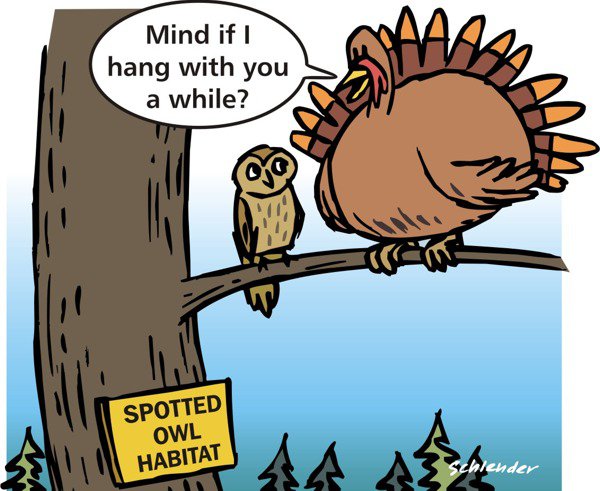It’s ‘Wildlife week’ on the Garden Professors. One of the most common questions that we get when speaking to garden groups is, “What can I do around my home to promote wildlife?” My stock answer used to be, “Throw a party!”, but only a handful of people ever got it so I’ve backed off of that one. Anyway, since the subject of gardening and wildlife comes up so often we’ve decided to dedicate a week to the topic.
Questions about wildlife (the animal kind) always take me back to my undergraduate forestry days at Washington State University and Dr. Zamora’s Wildlife Management course. Even though I’ve always been more of a plant person than and an animal person, I found this to be a fascinating course. In fact, assembling the winter browse twig ID collection was one of my proudest undergraduate achievements. Doesn’t seem like much; but try wandering the Palouse hills in the dead of winter and see if you can indentify 50 browse species without the benefit of leaves, you’d be proud too! In addtion to a notebook full of mounted twigs and a mild case of frostbite, I took away from the course several key principles of wildlife management that have stayed with me over the years.

What do wildlife need? In general, all wildlife need four basic elements: food, cover, water, and space. The specific types and amounts of these elements, of course, will depend on the type of wildlife you wish at attract. Homeowners can provide or enhance these elements through plants or through other, non-living means. Important non-living components include feeders, bird-baths or other water features, piles of rocks or sticks (provide cover for small animals), salt, and standing or fallen dead trees (provide habitat for cavity-nesting birds and mammals). Plants can provide both food and cover. Important plant components in designing for wildlife include evergreen conifers for cover, summer fruits and berries, fall fruits and seeds, winter fruits and seeds, flowers that provide nectar, and trees that provide nuts and acorns.
At this point the questions often turn to the importance natives versus exotics. In light of Doug Tallamy’s book, Bringing Nature Home, many people assume that only native plants can serve these functions. But there are several factors to consider here. First, Tallamy’s discussion is largely focused on co-evolutionary relationships between native plants and native insects, and even here some of the reasoning is stretched thin (see Linda’s Feb. 12 post). There is more to supporting wildlife on a broad scale than insect/herbivore interactions. Non-invasive exotic conifers, for example, can certainly contribute winter cover, vertical structure, and edge effects. And, while some animals have evolved very specific diets (think koalas and eucalyptus), many herbivores are generalists and in some cases even prefer to feed on exotics. So, in thinking about wildlife it’s important to consider function and providing the elements animals need than to simply fixate on whether plants are native or exotic. This is especially true on tough, disturbed sites where natives may be poorly adapted and unable to survive. Habitat provided by an exotic will be preferable to no habitat at all.
Lastly, another factor to consider is whether attracting wildlife around your home is always a good idea. Along with the wildlife we’d like to see, improving habitat may increase the likelihood of running into critters (skunks, raccoons, possums) that we’d rather not encounter on the way to take the trash out late at night. Also, in many parts of the country, people and their pets are encountering large predators such as cougars and bears with increasing frequency. Obviously a lot of this is due to human encroachment into the predators’ habitat, but it may be prudent to consider a ‘defensible space’ strategy as we do for wildfires. Keep the elements that are likely to attract larger animals a safe distance from the house. Stay tuned for more as ‘Wildlife week continues’.
NOTE: Thanks to my high school choir-mate and college soccer team-mate, Tim Schlender for the timely wildlife habitat cartoon.
What a great start for the week! I am twittering to all my followers so they can find your information. Thank you!
If only there was a way to keep the wildlife around when I DON’T have ripening fruit, and magically make them go away when I do. I have tried to attract wildlife to my little corner of suburbia. Now I am starting to wonder at the wisdom. I lost nearly my whole heirloom tomato crop to a family of marauding raccoons, nearly killed a robin and a mockingbird who got tangled in the bird netting over the cherries.
But later this season when it’s cold & gloomy, I know I’ll appreciate watching the birds and squirrels eating the food I’ve put out for them. And I’ll be thankful the bigger creatures haven’t gotten brave enough to give my backyard a try yet.
I can testify that you don’t need to grow only natives to attract wildlife. I live in the city, and have no desire to attract mammalian wildlife. The coons and possums are a threat to my chickens. The Eastern gray squirrels are an invasive, alien species, but the walnut tree brings them here. Now that I have chickens, I even have mixed feelings about the birds. They carry avian diseases. Heck! I had to rescue my favorite hen from the claws of a bald eagle. Fortunately for the birds, the mixed, layered plantings I prefer, and the big old trees that came with the place are attractive to them. I’ll admit to having a soft spot for the crows who were responsible for me saving Roz from the eagle.